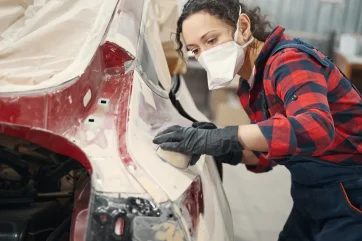
The white-hot flame that was Cazoo burned out in May, and remarketing experts often make mention of its embers. In case you blinked and missed it, the firm – launched in 2018 by Zoopla and Lovefilm founder Alex Chesterman – promised to revolutionise the used car market by offering online sales and home deliveries, with a side order of subscription. It listed on the New York Stock Exchange for a stratospheric £6.5bn in August 2021, but that was too close to the sun, and it canned its subscription arm in June 2022 and called time on the used car business almost two years later. The brand remains as a used car website a la Auto Trader but is now owned by Motors.co.uk.
Part of the company’s strategy was to get its arms around as much of the UK’s remarketing sector as it could, including several refurbishment specialists, such as SMH Fleet Solutions – which was closed in March 2023 – and Greenhous, with the facilities dedicated to Cazoo’s vehicles, which constrained capacity in the sector.
Refurbishment facilities felt it acutely, not least because they were facing other pressures, such as technician and parts shortages. In July, two months after Cazoo’s closure, the Vehicle Remarketing Association (VRA) described “substantial bottlenecks in preparing cars and vans for sale”.
Things changed in the second half of the year, though, as remarketing experts now say the backlog has largely cleared and that refurb capacity has increased in the wake of Cazoo’s demise. Greenhous bought back its Livingstone and Cold Meece sites – which it previously sold to Cazoo – in October 2023 and February 2024, and they are processing open-market vehicles again. Other specialists have revamped existing refurbishment facilities or are opening entirely new sites, such as City Auction Group, which announced in September that it was developing a new 28-acre logistics centre at Wittering, near Peterborough.
“Cazoo had hoovered up a lot of capacity within refurbishment centres,” says Marcus Blakemore, chair of the VRA’s industry trends committee, “obviously they are no longer, so those refurbishment centres have been repurposed. Some of our members are now telling us there are new providers knocking on their doors saying, ‘we’ve got capacity’. Having them back again, I think, is a really healthy market for refurbishment.”
Used market effect
The slowdown in the number of ex-fleet vehicles hitting the used market has also made its mark. Few cars and vans were built in 2020 and 2021 and, although the pandemic and the semiconductor shortage are, for the most part, behind us, there is little in the way of sub-four-year-old stock.
“If you look at the volume of products at 0-12, 0-24, 0-36 months, it isn’t high,” explains Philip Nothard, insight director at Cox Automotive and VRA chair, “and to a degree, EV products are being held back a little bit by the fleet and leasing and rental sectors, because they don’t want to drop everything in at once and run the risk of huge depreciation again.”
Speaking on condition of anonymity, one industry source told us that refurb services were often viewed as an upsell and a significant revenue stream for remarketing companies and leasing firms with their own facilities, and that buyers able to handle repairs in-house – such as car supermarkets – prefer to. Nonetheless, they claimed there was demand for refurb, particularly when the used vehicle market slows, and buyers become more selective. Blakemore agrees that those who can fix their own vehicles are keen to, but suggests most retailers lack the resource, and those who have it are often limited to smart repairs.
“Some leasing companies are quite happy to sell their cars, as I would call it, raw – they’ll take the lower value because they’ve not had to put into any prep – and some people are happy to put the car through a process. [Demand] is driven by customers that want to buy the cars, but don’t have the ability to refurb themselves. A lot of people do their own smart repairs, but it’s when it becomes structural that there’s a challenge.
“If you go back 10 years, a lot of dealers had their own body shops on site, and they could do it themselves. Now they’re not the common thing, so they have to outsource it. It’s more challenging to sell grade four and five cars, and there’s a lot of effort involved to get that car up to a retailable standard.”
Uncertain outlook
All the above is good news if you have vehicles in need of some prep, but the status quo may not last. The scarcity of sub-four-year-old ex-fleet vehicles means those available are often older and not in the best of conditions.
“The age and mileage profile of product coming through the lanes is getting worse,” adds Nothard, “it’s older stuff, it’s high mileage. That comes with prep costs.
“We’re not getting a huge amount of volume coming into the refurb centre, so we’re not seeing it so much yet, but I think, whenever that tap is opened – and it will open – whether it’s December or whether it’s into the new year… that could put pressure on vehicle refurb again.”
Our anonymous source said they were not expecting significant volume to return to the used car and van markets until 2026 and suggested demand for refurb may not rise in tandem, because there would be more vehicles available in a variety of conditions. Blakemore adds that parts availability has also played a role in getting vehicles ship-shape: “There’s still quite a parts issue for a lot of vehicles. Quite a lot of components from different manufacturers are running on back order.”
Sources have told Business Car that fleets and leasing companies have resorted to buying parts from eBay, because manufacturers cannot supply them with replacements, while wait times for diagnostic work are exceptionally high. Look at it that way, and it is not difficult to see the value in a refurbished used vehicle, especially for dealers after a clean example for a quick sale.
Storage hunters
Vehicle refurbishment capacity may have loosened up, but new vehicle storage is said to be the current major logjam in the logistics game. It is primarily down to congestion at ports (Bristol, Southampton, and Plymouth were mentioned by more than one source but they are allegedly not alone) as swathes of new vehicles are simultaneously imported. A significant amount is reportedly from new entrant brands, some of which lack established dealer networks and/or logistics partners with the links to move them on.
“One OEM reached out to us to move vehicles out of the port to a facility inland,” explains Gary Xuereb, sales and inspections director at vehicle inspection and logistics specialist DMN Group, “they couldn’t bring any more cars into the country. The port wouldn’t let them, because the port was blocked.”
“There’s just a constant flow of boats coming in,” adds Blakemore, “there’s BYD, obviously Tesla are still pumping in cars like you wouldn’t believe, you’ve got Chery, Omoda, and Jaecoo – plus all the other manufacturers. It feels like we could end the year on two million vehicles.”
The dockside gridlock is also adding huge cost for manufacturers, as any additional layer in a vehicle’s journey to its owner does not come cheap.
“Most OEMs will do the first delivery to a dealer, to a lease co, or to a rental company as part of the [overall] charge,” says Xuereb, “but obviously, this is the first delivery [from the port to the storage facility], then they’re going to have to pay again to move them on. It’s like a double bubble.”
The Financial Times reported that European ports have also been affected by the same issues, and that falling new car sales and a shortage of lorry drivers had contributed to the issue, with some vehicles reportedly sitting in ports for up to 18 months.
Supported by:






